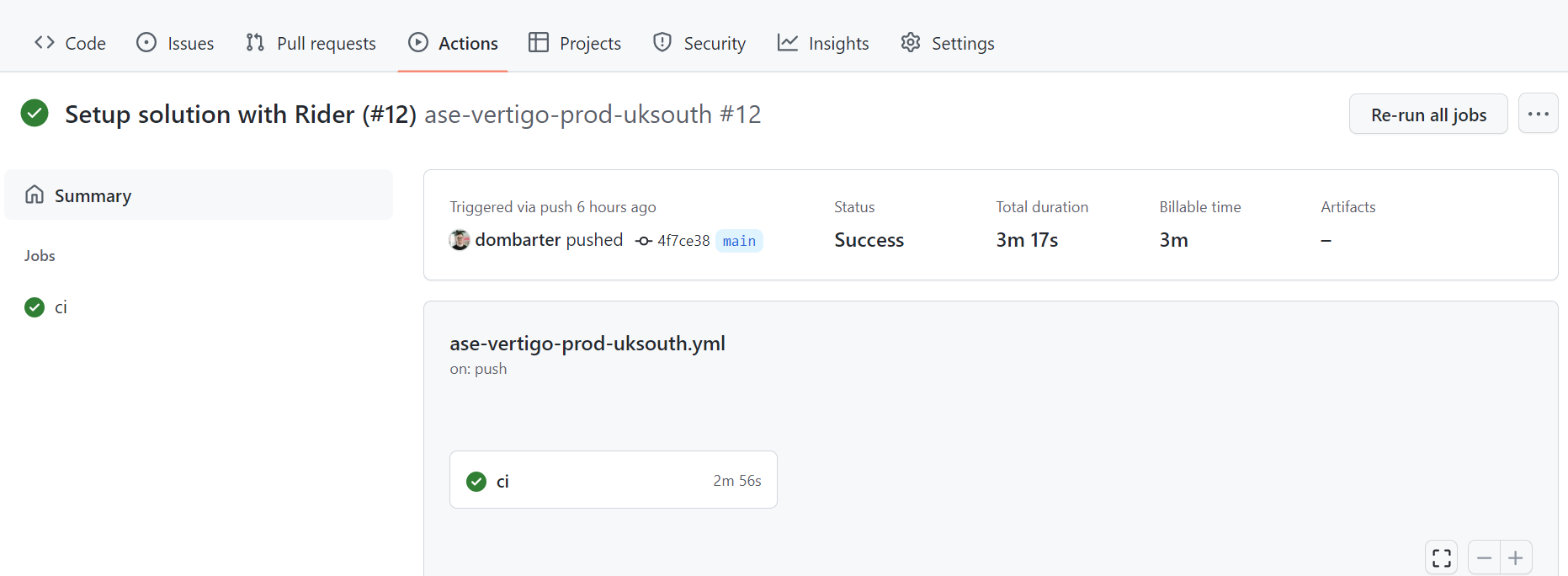Motivation
As part of my dissertation project at university I needed a simple CI/CD pipeline to continually test and deploy my API to Azure.
Setup
Go to your project and create a new folder called .github, with another directory within called workflows. Inside this folder you want to create a yml file. I decided to name mine after my Azure resource:
ase-vertigo-prod-uksouth.yml
Now you need to paste in this basic workflow:
# Action name
name: ase-vertigo-prod-uksouth
# Branch triggers
on:
push:
branches:
- main
workflow_dispatch:
jobs:
ci:
runs-on: windows-latest
steps:
# Checkout git repository
- uses: actions/checkout@v2
- The
namewill show up inGitHubto show you which action you are running - The
onsection defines triggers for the workflow: on push tomainand amanualtrigger - And finally we will run on a
Windowsmachine, and checkout the repository
Restore NuGet packages
Add the following step to restore all NuGet packages in the solution:
# Restore NuGet packages
- name: Restore
run: dotnet restore
Build and publish the API project
Add the following step to build the API project and publish it to a set directory:
# Build and publish the API project
- name: Publish
run: |
cd ${{ env.API_PROJECT }}
dotnet build --configuration Release
dotnet publish -c Release -o ${{env.DOTNET_ROOT}}/myapp
Test the project
Add the following step to run a xUnit test project (in our case, some API integration tests):
# Test the API project
- name: Test
run: |
cd ${{ env.API_TEST_PROJECT }}
dotnet test
Deploy to Azure App Service
Add the following code to take the published bundle and push it to Azure App Service:
# Deploy to Azure
- uses: azure/webapps-deploy@v2
name: Deploy
with:
app-name: ${{ env.AZURE_WEBAPP_NAME }}
publish-profile: ${{ secrets.AZURE_PUBLISH_PROFILE }}
package: ${{env.DOTNET_ROOT}}/myapp
Environment variables
We need to add some environment variables at the top so our workflow knows which projects to build and what the Azure app service is called:
# Environment variables
env:
API_PROJECT: Vertigo.API
API_TEST_PROJECT: Vertigo.API.Test
AZURE_WEBAPP_NAME: ase-vertigo-prod-uksouth
You can also add any extra environment variables if they are needed by the test project for example.
Configure Azure publish profile
Finally we need to get a private setting called an AZURE_PUBLISH_PROFILE from our app service to create an authenticated deployment.
Follow the steps here: https://learn.microsoft.com/en-us/dotnet/devops/dotnet-publish-github-action#add-publish-profile
Final steps
The workflow should then appear automatically in GitHub, and run on one of the triggers:

Complete Workflow
Here is the complete workflow with all the changes:
# Action name
name: ase-vertigo-prod-uksouth
# Branch triggers
on:
push:
branches:
- main
workflow_dispatch:
# Environment variables
env:
API_PROJECT: Vertigo.API
API_TEST_PROJECT: Vertigo.API.Test
AZURE_WEBAPP_NAME: ase-vertigo-prod-uksouth
jobs:
ci:
runs-on: windows-latest
steps:
# Checkout git repository
- uses: actions/checkout@v2
# Restore NuGet packages
- name: Restore
run: dotnet restore
# Build and publish the API project
- name: Publish
run: |
cd ${{ env.API_PROJECT }}
dotnet build --configuration Release
dotnet publish -c Release -o ${{env.DOTNET_ROOT}}/myapp
# Test the API project
- name: Test
run: |
cd ${{ env.API_TEST_PROJECT }}
dotnet test
# Deploy to Azure
- uses: azure/webapps-deploy@v2
name: Deploy
with:
app-name: ${{ env.AZURE_WEBAPP_NAME }}
publish-profile: ${{ secrets.AZURE_PUBLISH_PROFILE }}
package: ${{env.DOTNET_ROOT}}/myapp
References
https://learn.microsoft.com/en-us/dotnet/devops/dotnet-publish-github-action